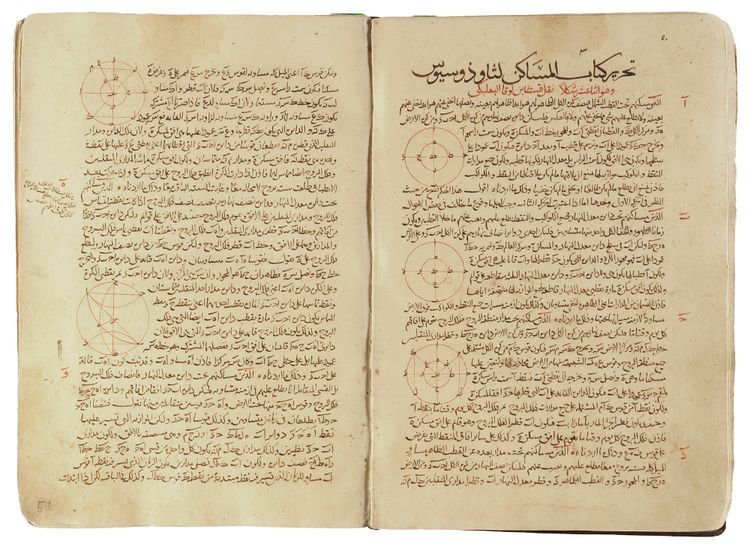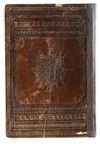A COMPENDIUM OF TREATISES ON ASTRONOMY AND MATHEMATICS, 1279, NASIR AL-DIN AL-TUSI (DIED 1274)
A golden age of Islamic science Nasir Al-Din Tusi and quote Al-Din Shirazi. This manuscript bears witness to the academic lives of the celebrated Ilkhanid astronomer, Nasir al-Din Tusi and his most renowned pupil, Qutb al-Din Shirazi, two of Islam’s principal scholars, who made major contributions to medieval mathematics, astronomy, and philosophy. Written in Seljuk Anatolia in 1279 AD, only five years after Tusi’s death and during Shirazi’s lifetime, it is a fascinating and rare document which gives a particularly striking illustration of how scientific knowledge was passed down from one generation of scholars to another. It comprises five treaties by Tusi, including a previously unrecorded risala as well las his seminal commentary on Ptolemy’s Almagest, Tahir al-majisti. These five treatises were copied by Shirazi from Tusi’s own autograph copies, and Shirazi’s manuscript was then copied in Anatolia by one of his students to produce the present work. Copious notes in the margins show how highly regarded this copy was among later scholars.
A COMPENDIUM OF TREATISES ON ARITHMETICS AND ASTRONOMY, INCLUDING A PREVIOUSLY UNRECORDED RISALA AND TUSI’S COMMENTARY ON PTOLEMY’S ALMAGEST; THIS MANUSCRIPT COPIED FROM AUTOGRAPHS BY NASIR AL-DIN TUSI AND QUTB AL-DIN SHIRAZI NASIR AL-DIN MUHAMMAD BIN MUHAMMAD BIN AL-HASAN AL-TUSI (D. AH 672/1274 AD): A COMPENDIUM OF TREATISES ON ASTRONOMY AND MATHEMATICS SELJUK ANATOLIA, PROBABLY KAISERI (QAYSARIYA), DATED BEGINNING RABI’I AND END OF JUMADA I AH 678/JULY AND OCTOBER 1279 AD
Five treatises on astronomy and mathematics. Arab manuscript on paper, 153 leaves plus two fly-leaves, each folio with 29 lines of flowing sepia naskh, important words and phrases picked out in red, numerous diagrams and tables throughout, some titles in strong larger naskh, copious marginal notes throughout in sepia and red. Later numbering in ink in the upper outer corners, small areas of staining and repair throughout. In 14th or 15th century Morocco binding with stamped geometric stellar motif and geometric borders, spine repaired, the doublures with scrolling arabesque. Folio: 24.4 by 16.6 cm.
Nasir al-Din Abu Ja’far Muhammad al -Tusi (d. 1274 AD), who is described as the original musannif (compiler) of the text in this manuscript was born in Tus in AH 597/1201 AD. He was the most eminent scholar of the medieval world in trigonometry and wrote on a wide range of topics within the areas of mathematics and astronomy as well as on logic and theology. He composed about 150 works and is well-known as the founder of the observatory at Maragha in 1259 AD for the Ilkhanid ruler Hülegü, which triggered a major renaissance of Islamic Astronomy bringing together a number of outstanding scientists such as Qutb al-Din Shirazi. He is considered by the medieval historian Ibn Khaldun as batter than any other later Iranian scholars. Tusi died in Baghdad in 1274 AD.
Qutb al-Din al-Shirazi studied medicine and law under his father Mas’ud al-Qadharuni and was later the best pupil of al-Tusi in astronomy and philosophy. He worked as a judge in Sivas, Malatya (Anatolia) and various cities in North-West Iran as well as carrying out various diplomatic missions for Ilkhanid rulers. Shirazi was probably in Anatolia when our manuscript was copied from his own copies. After one such mission for the Ilkhanid Ahmad Tekudar (1282-1284 AD) in Egypt, al-Shirazi moved to Tabriz and worked at the courts of Ghazan Khan and Uljaytu as well as founding a new astronomical observatory and scientific school in Tabriz He died in 1310-11 AD.
The present work is a version of Al-Majmuá all-Mutawassita or Kitab al-Mutawassitat, a compendium of treatises on Mathematics and Astronomy described by Tusi as ‘intermediate’ lying between Euclid’s Elements and Ptolemy’s Almagest (‘Nasir al-Din Tusi’, Encyclopedia of Islam, pp.929-932). It contains treatises of which, in most cases, he had written commentaries or new editions himself, mostly composed during Tusi’s most active years in the 1250s and 1260s.
A copy of the Kitab al-Mutawassitat, also including Tahriri kitab al-masakin li thawdhusyus was sold at Sotheby’s, London, 7 October 2009, lot 21. It was dated 1283 AD. Another sold at Christie’s London, 31 March 2009, lot 11 dated within 20 years of Tusi’s death.
Our manuscript comprises the following works: • Jami’al-hisab also known as Jawami’al-hisab (bi’l-takth wa’l-turab), Collection of Arithmetic by Means of Board and Dust’ (see Rosenfeld, no. 606 – M17, p.214) (f.1 as numbered). A note on its last folio states that it was copied from a manuscript that Qutb al-Din Shirazi copied from an autograph by Tusi dated 20 Rajab AH 66 3/8 May 1265 AD.
• An unrecorded single page risala which according to the index at the beginning of the volume is entitled risala fi ikhtilaf awda’marakiz aflak útarid fi masiratiha wa maqadir ab’ad markaz al badr’’an markaz al-‘alam (f.23) (Epistle regarding the trajectory of Mercury).
• Kitab al-tadhkira fi’ilm al-hay’a, ‘A Memoir on the Science of Astronomy’ (see Rosenfeld, no. 606-A10, p.216) (f.24) Its colophon states that it was copied in a madrasa in Kaiseri (Qaysariya), in Anatolia at the beginning of Rabi’I AH 678/July 1279 AD from a manuscript copied by Qutb al-Din Shirazi, itself copied from an autograph by Tusi who had completed it on 8 Ramadan AH 661/16 July 1263 AD.
• Tahrir kitab al-masakin li thawdhusyus, ‘Exposition of the ‘Book of Settlement’ of Theodosius’ (see Rosenfeld, no.606—A5, p.216) (f.49). Theodosius was a Greek scholar (ca. 160-100 BC) whose work was originally translated into Arabic by Qusta bin Luqa (820-12 AD). Nasir al-Din Tusi wrote his own commentary on this work. This treatise is complete but is not dated.
• Kitab tahrir majisti, ‘Exposition of “Almagest’ (see Boris A. Rosenfeld and Ekmeleddin Ihsanoglu Mathematicians, Astronomers and other Scholars of Islamic Civalixation and their Works.(7th-19th century) Istanbul 2003, 606, pp.211-219 and Brockelmann, 670-676; S.I, 924-933) (f.54) This is Ptolemy’s (d. 168 AD) major astronomical work. It was originally translated into Arabic by Al-Hajjaj bin Yusuf bin Mattar (d. 833 AD) on the order of Caliph al-Ma’mun (d. 833 AD), then by Ishaq bin Hunayn (d. 910 AD) and edited by Thabit bin Qurra (d. 901 AD) both of whom are mentioned in Tus’s preface. He also credits in his preface Husam al-Din bin al Hasan bin uhammad al-Siwasi, a 13th century Anatolian astronomer. Tusi’s commentary of the Almagest, completed in 1247 AD, is probably the most celebrated of all. Our colophon is dated Jumade I AH 678/October 1279 AD and this is probably one of the earliest copies of this work. A later added note states that it was copied by a student of Qutb al-Din Shirazi, itself copied from an autograph by Tusi.
According to the colophon of the third treatise, the manuscript was copied in Kaiseri, Anatolia. A scientific treatise on astrolabes in the Al-Sabah Collection, Kuwait was also copied in Kaiseri in 1231-38 AD. It displays a very similar cursive hand and although written 40 years earlier, shows that the Central Anatolian town was an established Seljuk manuscript centre (Court and Cosmos, exhibition catalogue, 2016, cat.115, p.194).
PROVENANCE Private collection, Sweden Christie's, 26 April 2018, lot 36








